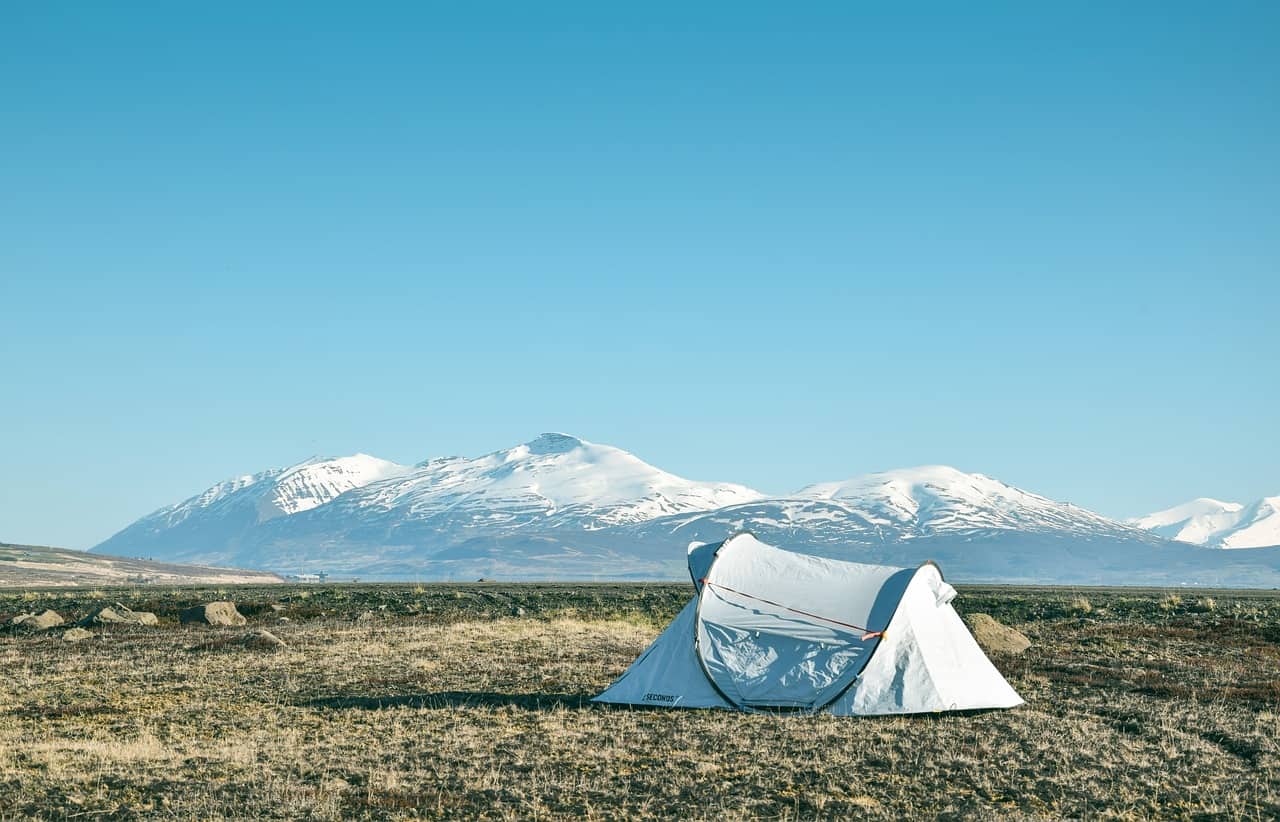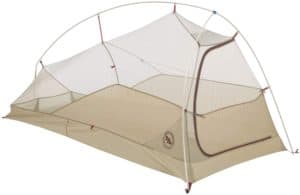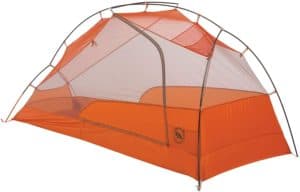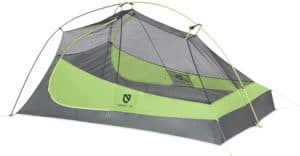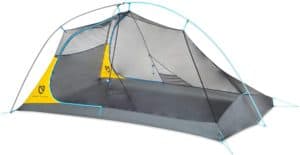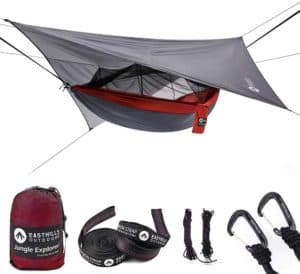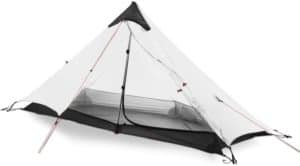Selecting and choosing the right tent is always an important decision for any camper.
As the tent is the one piece of equipment that will provide most of their security, comfort, and shelter while camping.
However, when you’re a thru-hiker or backpacker choosing a tent takes on a whole other level of importance and difficulty.
Because not only does the tent need to be reliable and well built but it also must be extremely lightweight and compact so that it’s easy to pack and hike with.
So as hiker and backpacker myself I did a ton of research and field testing to figure out exactly which ultralight tents under 2 lbs are the best ones.
In order to help you select the best lightweight tent for your needs.
Best Tent’s Under 2 lbs: Top Ultralight Backpacking Tents
When it comes to ultralight tents and camping light, no one tent will fit every camper, backpacker, or thru-hikers needs.
So instead of trying to select just one tent as the best ultralight tent I instead chose several different tents that would work best for different situations and needs for individual campers.
However, in order for the tent to make this ultralight best-of-list, it had to have several elements and characteristics including it must weigh below or very close to 2 lbs, it must be reliable and well built, have adequate head-space, easy entry and exit points, and a functional and well thought out design.
Big Agnes Fly Creek HV UL Ultralight Backpacking Tent
- Weight: 1 lb 15 oz (Trail Weight of 2 Person Model)
- Capacity: 1, 2, and 3 Person Models
- Freestanding: Yes
- Number of Seasons: 3
This ultralight tent from Big Agnes is one of my favorites on this list because everything is so well thought out and designed. While most ultralight camping tents have a very low ceiling or center height in order to keep the weight down. Due to the unique design of the Fly Creek HV UL, Big Agnes was able to create a center height of 40 inches which is almost unheard of with ultralight tents.
There is also plenty of floor space with the 2 person model with 28 square feet, allowing 2 people to comfortably sleep in the tent without feeling too cramped. To be honest though if two average-size adults are sleeping in the tent there is very little room left over for your gear.
The great thing though is that this ultralightweight tent comes with a built-in vestibule, allowing additional covered space to store all of your camping and hiking gear while inside the tent.
In addition with its 3 season rating, full rainfall, complete waterproof coating, and full taped seams this tent can handle everything from a light drizzle to a full-on downpour.
So if you’re looking for a quality and well built ultralight backpacking tent than this tent is definitely worth checking out.
To see the price of this ultralight camping tent by Big Agnes on Amazon click here.
Big Agnes 2017 Copper Spur HV UL Backpacking Tent
- Weight: 2 lb 2 oz (Trail Weight of 1 Person Model)
- Capacity: 1, 2, 3, 4 Person Models
- Freestanding: Yes
- Number of Seasons: 3
Similar to the Fly Creek HV UL above Big Agnes has again knocked it out of the park with this ultralight backpacking tent. With a center height of 38 inches on the one-person model, it has one of the highest ultralight ceilings we have seen in the industry making it a breeze to move around inside the tent.
Also, thanks to its unique architecture and pole design this one-person tent by Big Agnes has a sizeable 20 square feet to work with while inside the tent. There-by allowing not only plenty of room for you and your gear but even enough room for your furry friend if you happen to be traveling with one.
One of the best things about Big Agnes tents though besides their lightweight, is how feature-rich they are, as it seems like they have thought about just about everything. And this tent is no exception with a ton great features built-in including a large vestibule, random rip-stop nylon for extra durability, large dual zipper door, and multiple storage pockets to store all your gear.
When looking for an ultralightweight tent, whether you choose the Fly Creek HV UL or the 2017 Copper Spur HV UL by Big Agnes you really can’t go wrong and it really just comes down to personal preference.
To check the price of the 2017 Copper Spur HV UL on Amazon click here.
Nemo Hornet Ultralight Backpacking Tent
- Weight: 1 lb 15 oz (Trail Weight of 2 Person Model)
- Capacity: 1 or 2 Person Models
- Freestanding: Yes
- Number of Seasons: 3
The Hornet Ultralight Backpacking Tent by Nemo is a great choice for any camper looking for a simple and lightweight design but still wants to maintain the maximum amount of interior space.
With its unique single mono-pole design this tent keeps the tent as simple and compact as possible making it great for any thru-hiker or backpacker trying to keep their pack weight and size down.
Just because the tent is super compact though doesn’t mean that there isn’t plenty of interior space to sleep comfortably inside. While the mono-polo design keeps things simple it’s patent-pending Flybar volumizing clips add a ton of usable interior space and height with a respectable 36-inches of center height. In addition, this tent uses volumizing guy-outs that connect the inner tent to the rainfly in order to maximize the usable interior space.
So even though this tent is in the ultralight tent category, when you’re inside the tent it really doesn’t feel like it because of how spacious and roomy the tent is on the inside.
One last unique thing about this tent especially for being an ultralight tent is that it actually has two doors and two vestibules instead of the standard one making it super easy for both tent mates to get in and out of the tent without having to crawl over one another.
To check the price of this spacious and lightweight tent by Nemo on Amazon click here.
Nemo Hornet Elite Ultralight Backpacking Tent
- Weight: 1 lb 11 oz (Trail Weight of 2 Person Model)
- Capacity: 2 Person
- Freestanding: Yes
- Number of Seasons: 3
If the standard Hornet Ultralight tent wasn’t extreme enough for you and you’re looking for the ultimate in weight reduction while backpacking than the Hornet Elite model might just be the one for you.
As one of the most expensive tents on this list it won’t be for everyone, but coming in at a mere 1 lb 11 oz it’s also one of the lightest, free-standing tents we have ever reviewed.
As the old saying goes “you get what you pay for” and this ultralight tent by Nemo is no exception as it’s easy to tell that every component and square inch of this tent was painstakingly designed in order to maximize weight savings while still preserving as much interior space as possible. Creating one of the lightest and well thought out ultra-light backpacking tents I have ever seen.
It’s not all about weight savings with this tent though because it also has a ton of great features including ultra-fine 7D rip-stop nylon fly with silicone water repellent, patent-pending Flybar volumizing pole clips, two spacious vestibules, and several storage pockets.
One other unique feature of this tent is that it comes with dual stuff sacks allowing the already light load of this tent to be divided into two separate packs. Allowing two people to carry this tent making the load and pack size even lighter and smaller for each camper.
To check the price of this ultimate lightweight backpacking tent for two on Amazon click here.
Easthills Outdoors Jungle Explorer Double Camping Hammock
- Weight: 2 lb 4 oz
- Capacity: 2 Person
- Freestanding: No
- Number of Seasons: 2
One of the most unique options on this ultralight tent list is this camping hammock by Easthills. While not your standard ultralightweight tent, if you’ve never considered a camping hammock before now might be the time. As camping hammocks are usually lighter when compared to traditional free-standing tents due to their lack of poles.
While this camping hammock might not be the lightest option when comparing it to other ultralight tents, it is still very light, weighing in at only a little over 2 pounds. And the great thing about this ultralight camping hammock is that it costs a fraction of what a typical ultralight freestanding tent usually costs.
While a camping hammock might not be for everyone it’s definitely something worth checking out when you’re looking for a light tent option to camp and backpack with.
There are a few drawbacks to camping hammocks though that you should be aware before choosing this type of ultralight tent option including its lack of free-standing ability, less capable to handle cold weather conditions, and lack of interior space to store your gear.
To check out this unique ultralight backpacking tent option on Amazon click here.
KIKILIVE Ultralight Trekking Pole Tent
- Weight: 2 lb 7 oz (1 Person Model)
- Capacity: 1 or 2 Person
- Freestanding: No (Requires Trekking Pole)
- Number of Seasons: 3
While not the lightest tent on the market any tent that comes in under 3 pounds can easily be classified as an ultralight tent.
This ultralight tent by KIKILIVE is a great option if you are looking for a lightweight tent but don’t want to break the bank. Because this tent is less than half the cost compared to some of the more expensive ultralightweight tents.
Even though this tent might be on the cheaper side when it comes to ultralight backpacking tents, it still offers a lot of great value and quality. To begin with, the fly-tarp is made from 15D waterproof nylon to help make sure you stay dry no matter what the weather looks like outside. In addition, this ultralight tent is also a 3 season tent with tons of storage pouches inside to help keep you organized while camping.
Please be aware that this tent is a trekking pole tent, meaning this tent is not free standing out of the bag and requires an external trekking pole for its center support. So without a trekking pole or support of some kind in the center of this tent, it will not stand up.
Now, this might understandably by a turn off for some people. However, if you’re already hiking with trekking poles, this really shouldn’t be too big of a deal. And by cutting out the weight of tent poles from this tent set up, it allows this tent to come in at a lightweight while still remaining affordable.
To check out this affordable ultralightweight camping tent from KIKILIVE on Amazon click here.
River Country Products Trekker Tent 2
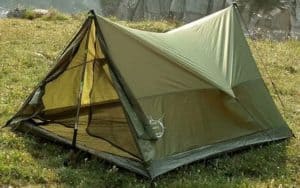
- Weight: 2 lb 12 oz
- Capacity: 1 Person
- Freestanding: No (Requires Trekking Poles)
- Number of Seasons: 2 (Not Waterproof)
Another trekking pole tent option is this ultralightweight tent by River Country Products. While you do need trekking poles to act as the supports for the tent just as you do with the above KIKILIVE Trekking Pole Tent, as the cheapest ultralight tent on this list it’s definitely worth checking out, especially if you already hiking with trekking poles.
Also, something to keep in mind with these trekking pole style tents is that you can actually use branches or any other type of pole that you might have around as long as it is long enough.
Please be aware that this tent while sprayed with a waterproofing spray is not completely waterproof. So if you are looking for a completely waterproof tent this might not be a good option for you unless you add a waterproof tarp over the tent.
Overall this a quality well-made tent but for the most serious of hikers and backpackers this tent will probably not work due to its lack of waterproofing capabilities. However, if your looking for an affordable basic tent that keeps your pack light and doesn’t take up to much room this tent might be worth checking out.
To check the price of this affordable basic lightweight camping tent on Amazon click here.
What to Consider When Buying an Ultralight Tent
Before selecting an ultralight tent you must take several considerations into account to ensure that you select the best ultralight tent for your specific needs.
While the number of factors and considerations could be endless when it comes to choosing the best ultralight tent. There are 5 main points that you must consider when choosing the best ultralight tent including weight, design, interior space, tent capacity, and seasonability to make sure you pick the best tent for your needs.
Ultralight Tent Weight
When selecting an ultralight tent there is perhaps no more important factor than the tent’s weight, even if this means you have to sacrifice some level of comfort or usability.
Because you choose an ultralight tent not, for its endless features and comfort but because it keeps the weight of the tent as minimal as possible.
While most tents have an eye on weight reduction to make them more portable and easier to manage, when it comes to ultralight tents they take this concept of weight reduction to the extreme. By looking at every component, feature, and material with the one over-arching goal of reducing weight.
How Much Should an Ultralight Tent Weigh?
So how much should an ultralight tent weight? In general for a tent to be considered ultralight at the bare minimum it needs to weigh less than 3 pounds. However, for most backpackers and thru-hikers they ideally like to see the tent weigh either at or below 2 pounds.
Weight vs Cost
All of this weight reduction does have a cost though because typically the lighter and more compact the tent is the more expensive it is.
As lighter and more compact tents typically must you more advanced design features as well as premium components in order to reduce the weight of the tent to its extreme lows.
So while weight is one of the most critical factors when choosing an ultralight tent you also must keep your budget in mind at the same time making sure not to break the bank.
Remember when choosing an ultralight tent that while every ounce counts while backpacking and thru-hiking its also important to keep your budget in mind.
To give you a basic understanding between ultralight tent weights verse their cost we created this below table that breaks down the general cost associated with different ultralight tents in regards to their weight.
| Ultralight Tent Weights | Average Price Range |
| Lightest | $400 – $500 |
| Average | $250 – $400 |
| Heaviest | $100 – $250 |
Ultralight Tent Design
Often times backpackers or thru-hikers will completely forget about design and comfort all together focusing only on finding the lightest possible tent, however, this strategy is usually a mistake.
While there is no doubt that weight should be a primary concern when selecting an ultralight tent, to select the lightest tent at the sacrifice of everything else is a decision you will more than likely regret over time.
Because while the lightest and most compact tent might be great while stored in your pack on the trails if it’s not functional and somewhat comfortable at camp what’s the point.
So when selecting an ultralight tent, yes, check the weight but also look at the overall design and features of the tent as well, making sure the tent will be comfortable and dependable while at camp.
Must-Have Design Features for Ultralight Tents
- Easy Entry and Exit Points – Make sure the tent is easy to get in and out of by making sure the tent has large doorways that open completely with quality zippers.
- Completely Waterproof – Unless you are going on short trips where you know the weather will be mild with no rain, make sure the tent is completely waterproof. Never sacrifice a tent’s waterproofing for weight reduction, it’s just not worth it.
- Easy Set-Up and Take Down – Look for an ultralight tent that is both easy to set up as well as take-down to avoid frustration and hassle while backpacking.
- Good Interior Space – A reduction in the tent’s size is to be expected when reducing the weight of the tent but make sure the tent is not too small and still allows enough room to move around inside comfortably.
- Rugged and Sturdy Design – Make sure the tent is both sturdy and dependable made from quality and substantial materials. As often times manufactures of ultralight tents will eliminate structural support and material thickness in order to save on weight.
Interior Space
One of the most common sacrificed features of the ultralight tent is adequate interior space. And as mentioned above this is somewhat understandable as you can’t expect to have a big cabin style tent and still keep the overall weight down.
However, with that being said it’s still important when selecting an ultralight tent that you at least keep the tent’s interior space in the back of your mind. Ensuring that the tent has at least a basic amount of interior space that will allow you to sleep and move around comfortably inside the tent.
How Much Interior Space Should an Ultralight Tent Have?
When trying to figure out how much space an ultralight tent should have there are two figures that you should be aware of including the center height or the highest point of the tent and the square footage of the tent’s footprint.
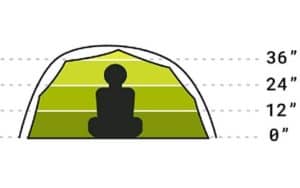
In regards to the tent’s center height, ideally you want to have a minimum of 36 inches of headroom to provide enough space to allow you to sit up and move around inside the tent.
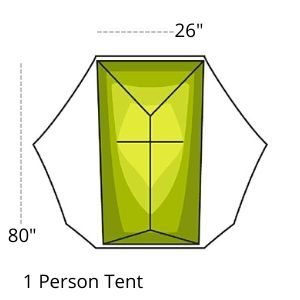
When it comes to an ultralight tent’s footprint there are really two numbers that you need to concerned with including the width and the length of the tent.
Obviously the acceptable minimum amount of inches for a tent’s footprint will vary depending on the capacity of the tent you choose though i.e. a 1 person tent or a 2 person tent.
As you can see from above if you opt for a 1 person tent than ideally at a minimum the tent should be no less wide then 26″ and no shorter 80″. If however, you choose a 2 person tent then ideally the tent should be no less wide then 40″ with the length being the same at no less then 80″.
By making sure that you have these minimum numbers for your ultralight tent’s footprint you will ensure that there is enough room for you as well as your gear without feeling too cramped or crowded in the tent.
Ultralight Tent Capacity
While there is no right or wrong answer when it comes to tent capacity, when you are selecting the best ultralight tent for your needs it’s important to decide what type of tent capacity you will need while backpacking or thru-hiking.
For many people, the obvious choice is a 1 person ultralight tent as this type of tent will be the smallest and lightest in your pack while hiking on the trails. However, a 1 person tent might not be the best for some such as a couple hiking together.
So when selecting a tent based on tent capacity just make sure you give some thought to who you will be hiking and camping with, that away you can select a tent capacity that will best fit your needs.
Ultralight Tent Seasonabilty
The last item to consider when selecting the best ultralight tent for your needs is the tent’s seasonal rating.
A tent’s seasonal rating is a rating that indicates the number of seasons the tent can handle. See the below table for further explanation on the different seasonal ratings for tents and what they mean.
| 1 to 2 Season Tent | Meant for warm weather and extreme mild perception found during the summer months. Usually, the lightest option but not meant for rainy or cold conditions. |
| 3 Season Tent | The most versatile and popular option, allowing you to camp during spring, summer, and fall. This type of tent can handle both warm and cold weather as well as a good amount of wind, rain, and snow. |
| 4 Season Tent | This type of tent can be used year-round as the season rating implies and can handle a fair amount of wind and cold weather. However, usually a poor choice for summer camping because of the tents restricted airflow. |
| 5 Season Tent | This type of tent is the most extreme and can also be called an expedition tent as it’s able to withstand extreme cold weather and windy conditions. Makes a poor choice for warm weather or summer heat due to its restricted airflow. |
For 90% of backpackers and thru-hikers selecting a 3-season rated tent will be the best choice. As a 3 season tent is the most middle of the road option and will offer the most flexibility when it comes to outdoor weather and temperatures.
While you can select a seasonal rating that falls more on the extremes such as 1 or 2 season tent or a 4 or 5 season tent. Just be aware that these types of tents are meant for very specific weather and will more than likely require you to own multiple tents in order to handle the different weather and temperatures found throughout the year.

